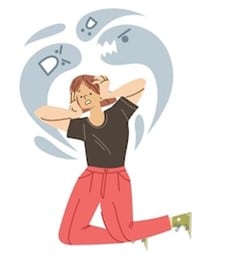As if the physical changes and conditions aren’t enough to cope with, medical trauma has a significant impact on our emotions. Healthcare providers may have facts and statistics to help us understand physical challenges, but they are less prepared to help us cope with the emotional swings that come with such experiences. Understanding typical reactions to some commonly felt emotions can help us move forward.
Unwanted Dependence and Vulnerability
It is so frustrating. I leave messages for my doctor. No call comes. I wait weeks for a needed test to tell me the next steps. Each minute, each hour, each day feels like an eternity. All this waiting. –LH
 As we go through surgeries, treatment, rehab, and more, many of us find we are launched onto an unfamiliar path. Despite the uncertainty, we try to gain balance, but we feel it is a bit like the playground seesaw. Sometimes we are lifted toward the sky, and other times, we are precipitously dropped to the ground. Finding the needed balance is difficult.
As we go through surgeries, treatment, rehab, and more, many of us find we are launched onto an unfamiliar path. Despite the uncertainty, we try to gain balance, but we feel it is a bit like the playground seesaw. Sometimes we are lifted toward the sky, and other times, we are precipitously dropped to the ground. Finding the needed balance is difficult.
As part of human evolution, we strive for independence. We can see the quest for independence throughout development. Two-year-old children push the limits and reject adult direction as they embrace their ability to walk, talk, and assert their desires. The quest surfaces more pronounced during the teenage years when adolescents recoil from having to ask for permission, request help, or respond to their parents’ inquiries about where they are going. Treasuring self-sufficiency in our adult years is considered a sign of success. Independence feels good. Yet the vulnerability and inherent dependence on professionals and others during this time can throw off the balance of what we’ve worked so hard to achieve.
 An even higher level of evolution is interdependency. Interdependence is the balance and rhythm of the seesaw. Interdependence recognizes that the extremes of dependence and independence miss the mark. Interdependence requires us to appreciate the value of working with others, engaging in give and take, and recognizing our limitations and needs. Interdependence increases our chances of survival and interpersonal growth. It’s okay to be lifted.
An even higher level of evolution is interdependency. Interdependence is the balance and rhythm of the seesaw. Interdependence recognizes that the extremes of dependence and independence miss the mark. Interdependence requires us to appreciate the value of working with others, engaging in give and take, and recognizing our limitations and needs. Interdependence increases our chances of survival and interpersonal growth. It’s okay to be lifted.
Waiting for calls and results was the hardest part. –MR
It was so hard to have a young child during this time of the unknown. Without me, she would be more vulnerable. –RGW
I suppose the most difficult feeling was one of vulnerability and not being in control. –MB
Worry, Anxiety, and Fear
 Many use anxiety, worry, and fear interchangeably. They all represent states of discomfort that can be experienced when we feel vulnerable, threatened, or uncertain. Anxiety, worry, and fear are emotional reactions with some similarities, yet they differ.
Many use anxiety, worry, and fear interchangeably. They all represent states of discomfort that can be experienced when we feel vulnerable, threatened, or uncertain. Anxiety, worry, and fear are emotional reactions with some similarities, yet they differ.
- Worry tends to create mild emotional distress
- Anxiety creates more persistent distress
- Fear is the sense of immediate danger
Worry
I passed off the treatments as an “inconvenience,” but inside I was worried that I could go through all of this and have no change in diagnosis. –DP
 Worry is a thought or an idea that can take different forms. We might ruminate about whether we are making the right treatment decision, whether or not our medical team is the best, what the outcome will be, or how our families will cope through this time.
Worry is a thought or an idea that can take different forms. We might ruminate about whether we are making the right treatment decision, whether or not our medical team is the best, what the outcome will be, or how our families will cope through this time.
Worry can move us to make decisions and problem-solve. If we are concerned about a treatment decision, we might contact others and ask their opinions, do research, and/or talk to experts. Worrying about the outcome can motivate us to seek complementary interventions, such as acupuncture, changing our diet, engaging in exercise, and more. Similarly, when we worry about how our family is coping, we can encourage them to identify friends they can talk to, ask others to check on them and have them talk to us about their concerns.
The ringing of the phone pierces the unrelenting agony of my pain. Suppressing what I am feeling in my voice, I answer in my best upbeat tone. I want to shield the caller from my pain. My intention is not entirely altruistic. Keeping much of my pain hidden shields me from their worry. –CS
I used to cry during the radiation treatments. I had a skin reaction to the tape they used and although I repeatedly told them about it, they ignored my complaints. This made me worry even more that they weren’t doing their job correctly. I didn’t trust them. –RG
I get distracted by worries. As I get my fifth blood transfusion, I think, what if something goes wrong? My mind takes me on that awful journey where nothing ends well. As thoughts spin around, I grab onto a fleeting thought, ‘Just be normal.’ I then visualize myself being healthy and fully engaged in life and all is okay in my world. When the winds of worry bend my sails, you’ll see me uttering, ‘Just be normal’ and my ship becomes right again. –CS
Cindy’s Journey I Hate Worry
Worry eats at my resolve and competitive nature to win this battle. Worry shifts me into the unknown. Worry takes me into the future of how my kids will handle the impact of this disease and my possible early death. Worry makes me sad, wondering if my grandchildren will remember me and if I will be around to see the grandchildren yet to come.
I hate worry. Worry makes me cry.
Anxiety
I’m not sure I could live life with the levels of anxiety that I was experiencing during treatment. While the treatment of leukemia was difficult, dealing with debilitating anxiety was exponentially worse. –GM
 Anxiety is characterized by thoughts paired with visual images. Thoughts and visuals are linked together to be stored in our minds. Engaging different parts of the brain creates a more powerful experience. Reading a book and picturing the scenes trigger the language and visual parts of the brain, which make the book more memorable. Movies create additional memory recall because they have words, pictures, movement, and sound — a brain feast! Because anxiety involves thoughts and images, it tends to have more power than worry and therefore is harder to control. Anxiety causes more distress.
Anxiety is characterized by thoughts paired with visual images. Thoughts and visuals are linked together to be stored in our minds. Engaging different parts of the brain creates a more powerful experience. Reading a book and picturing the scenes trigger the language and visual parts of the brain, which make the book more memorable. Movies create additional memory recall because they have words, pictures, movement, and sound — a brain feast! Because anxiety involves thoughts and images, it tends to have more power than worry and therefore is harder to control. Anxiety causes more distress.
Over the years, I have worked with many children and adults with anxiety. I thought I understood what it is like to have high levels of anxiety: heart palpitations, persistent thoughts, obsessive thinking, difficulty concentrating, and high startle responses that even sleep doesn’t quell. It wasn’t until I reacted to a medication that I truly learned what it is like to have uncontrollable levels of anxiety. During that time, I couldn’t move beyond the pain and reactions of the anxiety. I couldn’t control my thoughts and feelings. I felt at a loss as to what to do. I tried everything I could think of listening to music, walking, meditating, breathing, talking, and repeating positive statements, but nothing helped. It wasn’t until my physician determined I was having an allergic reaction to the medication and took me off of it. “It’s rare,” he said, “but it can happen.” Well, happen it did! I have a newfound level of compassion and understanding for those who suffer from chronic high levels of anxiety.
I felt very alone even though I met other people in the waiting room who were also going through radiation. We went from one waiting room to another. In the second one, you changed into the robe and waited alone. They had magazines to read, which were all about cancer. It wasn’t something I wanted to look at as I was about to enter my radiation treatment. I couldn’t believe that was the only reading material they had. It would have been good to have someone there to talk to about your fears and anxiety.
–RG
 My anxiety is so high. [Thoughts] that he really could die from the surgery as it was so long, what would he look like after it, will it come back, will this kill him, how much longer will he live… so many unknown answers. –LH
My anxiety is so high. [Thoughts] that he really could die from the surgery as it was so long, what would he look like after it, will it come back, will this kill him, how much longer will he live… so many unknown answers. –LH
I was anxious about the treatment and, at the same time, hated that people felt sorry for me.–DP
Fear
I felt fear associated with the unknown. Would the radiation be successful? Would it return? Would it spread? Am I doing the right treatment? Is it enough? You put your life, your faith, and your trust in people you don’t know. It’s a very frightening experience. –RG
Fear is essential to human survival. Without fear, our ancestors would have all been eaten by the mountain lion!
 Fear is a normal and protective response to danger, and certain fears are developmentally appropriate. Around the age of two, children’s brains can imagine and think about things that aren’t there. This is why you see a surge in creative play at this time. They can take cars and have them talk. Sitting at a computer, they pretend to type. Dolls need to be fed and changed. This is truly a time of wonder for those blessed to watch this emerging growth. While imagination and creativity are hallmarks of brain development, the brain can also imagine situations that create fear of the unknown: monsters under the bed, whether lightning will strike the house during a storm, and more. When the fear of the dark kicks in, nightlights are switched on, portable flashlights are tucked under the covers, and a snuggly toy becomes a source of comfort. These supports help soothe the brain until the fear passes.
Fear is a normal and protective response to danger, and certain fears are developmentally appropriate. Around the age of two, children’s brains can imagine and think about things that aren’t there. This is why you see a surge in creative play at this time. They can take cars and have them talk. Sitting at a computer, they pretend to type. Dolls need to be fed and changed. This is truly a time of wonder for those blessed to watch this emerging growth. While imagination and creativity are hallmarks of brain development, the brain can also imagine situations that create fear of the unknown: monsters under the bed, whether lightning will strike the house during a storm, and more. When the fear of the dark kicks in, nightlights are switched on, portable flashlights are tucked under the covers, and a snuggly toy becomes a source of comfort. These supports help soothe the brain until the fear passes.
In situations that aren’t usual (e.g., violence, hunger, abuse, crisis), fear remains high. At these times, fear takes on features of worry and anxiety. When feeling fear, worries, anxiety, obsessive thoughts, “what ifs” and the physical sensations of anxiety combine to create a high level of distress. Once the situation that evokes fear is lessened or removed (e.g., you heal, the crisis is over), the fear should diminish.
I was diagnosed with multiple sclerosis and eight months later with breast cancer. I was scared and terrified. I made sure all my affairs were in order. I wrote a letter to my husband, my daughter, and my sister to be opened upon my death. –SR
I was scared out of my mind, but I knew what I had to do. I was in the hospital for six weeks in a specialized isolation room. I received 12 blood transfusions, plasma transfusions, platelets, and chemo. The fear of not being around my twelve-year-old sons kept me on the edge of a cliff. –LL
I had a craniotomy. I was asleep for the five-hour operation. I was so frightened that I had them give me anesthesia before going to the OR. –JZ
[When preparing for brain surgery] I was afraid if things did not go well, I would be left alive with a severe brain injury like my Mom who was in a coma with brain trauma for months. –BK
Sorrow, Loss, and More
I was eight years old when I was diagnosed with skin cancer. I was so confused. My parents tried to explain what was going to happen, but I just wanted to do gymnastics and play. –AB
Worry, anxiety, and fear are heightened responses. They can make us feel like everything is revved up too much as if we are walking on unstable ground. Sorrow, sadness, loss, and the like lead to intense feelings pulling us downward. Just like anxiety, these feelings interrupt our regular thinking style and ability to function.
 Intense emotions of sorrow, sadness, and loss can override our sense of hope. Hope is an essential element in coping. It can be a Herculean task to build a solid life on days that lack hope. We cling to the notion that life will get better because, without hope, dark days become darker; sadness becomes deeper; beliefs become shattered; and giving up takes over.
Intense emotions of sorrow, sadness, and loss can override our sense of hope. Hope is an essential element in coping. It can be a Herculean task to build a solid life on days that lack hope. We cling to the notion that life will get better because, without hope, dark days become darker; sadness becomes deeper; beliefs become shattered; and giving up takes over.
The initial feeling of loneliness was sometimes overwhelming. –NA
Some of the meds had a side effect leading me to have a shorter fuse when dealing with family. –GM
PTSD has caused me to react in untypical ways. When I saw my teacher wearing a particular type of high-heeled shoes, I collapsed into a fit of hysterics. I was triggered because the social worker from Child Protective Services wore shoes like that when she was questioning me about the sexual abuse I experienced. –BR
I was so frustrated and angry that I couldn’t eat, sleep, speak, see well or take care of myself. I felt depressed and alone. –CK
To the casual observer, I look fine, but right below the surface the tears are ready to burst through. It happens. My heart opens a crack and here they come; not just a tear or a gentle sob, but a torrent of tears linked to sadness, worry, and memories. I quickly put a lid on it because I don’t know when the tears will end. I don’t have time to give into the flood. I have to be normal. I have doctors’ appointments, visitors, work, and healing to do. –CS
I was so debilitated physically that my emotional well-being depended on being able to get through the day. It was difficult to think beyond the treatment. I simply couldn’t imagine a day when life would return to “normal.” I was mired in my sorrow and couldn’t feel joy when someone close to me had good fortune. The “what ifs” took over my mind
and I had difficulty getting beyond that mindset. –JN
My daughter’s mental health crisis and her various treatments affect my mood. I feel extreme sadness. I feel guilty. I try to keep a positive outlook, but it is hard because I don’t have any control over outcomes. –KW
Keeping Emotions at Bay
Being interactive at work was therapeutic for me. It kept my mind off all the possible risks and side effects. –BK
 When in a crisis, we strive to “look okay,” as it can help us avoid feeling swallowed up by the challenges. While we might be able to dupe those around us, we know the truth as our emotions and thoughts knock within. Our jobs, families, and pleasures don’t wait for us to get stronger, feel better, or cope. Life marches on, whether we are ready or not.
When in a crisis, we strive to “look okay,” as it can help us avoid feeling swallowed up by the challenges. While we might be able to dupe those around us, we know the truth as our emotions and thoughts knock within. Our jobs, families, and pleasures don’t wait for us to get stronger, feel better, or cope. Life marches on, whether we are ready or not.
I wait as the salesperson ambles down the aisle. There’s no hustle. No sense of urgency. Doesn’t she know I could be dying? –CS
It is so difficult to try not to plan, not knowing what will happen to my health. –RZ
It was so hard to be isolated from the regular world. –MF
There were some days before the second surgery when I did a lot of work on myself and realized I could only be around people who could support me in a healthy way. I worked very hard on letting go of the result of the surgery. I remember the morning of my surgery, the nurse told me she had never seen such normal blood pressure. I was in a really good place. –GW
The emotions of these times can feel like hurricane season in the Atlantic Ocean. The emotional waves are choppy, rough, unyielding, and causing destruction in their wake; yet for some, there are moments of growth, clarity, and grace.
Many of the adults I work with in therapy who were undergoing significant crises have moments of rapid growth and self-awareness. Crises will do that to you. A crisis can bring us to our knees and draw out the deepest of our fears and emotions, while at the same time bringing us to a swell of understanding we might not have otherwise reached.
One woman I worked with had a series of miscarriages. Each one was a deeply felt loss. Her grief was deepened when others would make comments such as, “It’s better this way.” “Something must have been wrong with the baby.” After years of losses, she decided to give up on becoming pregnant. A different set of losses set in.
One day, she glided into my office and announced she was unexpectedly pregnant. As the weeks passed, her understandable worry took hold. She and her husband decided not to tell anyone she was pregnant, even their families, to avoid hearing comments that hurt.
On one particular Tuesday, she wasn’t in the waiting room when I went out to greet her. It was unlike her to be late. Five minutes into her appointment time, my phone rang. It was her husband. She was in the hospital. The night before, she had given birth to a baby boy the size of a soda can.
With her son in the university’s NICU, she resumed her appointments with me. I had never seen her look better. She shared that even though her son had multiple challenges and would likely have limited sight and developmental delays, she was happy. She was happy to be a mom, no matter what. This crisis gave her calmness despite what was happening and bound to occur. It made her realize that no matter what, she would be there for him, and even though she was sad that he would face hurdles in his life, her life was better for having him. Crisis can do that: it can help us see the gifts we have and define what is important.
Although diagnosed with acute lymphocytic leukemia (ALL) and bladder cancer, I was fairly calm. I focused on what I was grateful for and the life I had lived. I thought that if I licked this disease, any additional years would be a bonus. –GM
Despite having multiple sclerosis and breast cancer, I looked at the future head-on. I made the decision I wanted to live and just went from there. I had people I loved and art to create that was trying to get out of my MS brain. –SR
I always felt positive. I just knew I would pull through both bouts of different cancers. –LT
I don’t know if I ever thought I was going to die. I couldn’t imagine that. Of course, I knew multiple myeloma can be fatal, but I just didn’t go there. –NA
Living “Normally”
Try to function and live as close to normal as possible. –MB
There is nothing that feels normal about situations that disrupt our lives. Ready or not, the events propel us into an arena few are prepared for. With so much being different, we strive for normalcy in these abnormal times. Creating balance and maintaining valued parts of our lives help carry us through.
 One of the most inspirational examples of living “normally” is Maggie Kudirka. Maggie was a professional ballet dancer with the Joffrey Concert Group. At the age of 23, she was diagnosed with Stage IV metastatic breast cancer, requiring various treatments, removal of both breasts and loss of her hair. Anyone who knows dancers understands the dedication to their craft begins at an early age. Dancing is part of their souls, and Maggie is no different.
One of the most inspirational examples of living “normally” is Maggie Kudirka. Maggie was a professional ballet dancer with the Joffrey Concert Group. At the age of 23, she was diagnosed with Stage IV metastatic breast cancer, requiring various treatments, removal of both breasts and loss of her hair. Anyone who knows dancers understands the dedication to their craft begins at an early age. Dancing is part of their souls, and Maggie is no different.
Photo: Maggie Kudirka (by Luis Pons Photography)
Unable to continue to dance professionally due to the treatment and fatigue that accompanies this journey, Maggie became an ambassador for metastatic breast cancer. She created and hosted benefits for the Dancers Care Foundation and other organizations. She is now known as the Bald Ballerina (baldballerina.org). The beauty in her dancing and soul is evident to anyone who has seen her dance. Maggie would rather be performing, and not doing so is a loss and not “normal,” yet through it she has created a different dance. Through multiple treatments and medications, Maggie is 30 and continues to defy the odds.
I wanted to work. It gave me a sense of purpose. –RW
I pretended that everything was perfect. I spent a lot of time trying to make my environment perfect to correct how miserable we all were. I tried to ignore the bag of urine that was attached to my leg for four months, and the constant smell of leaking urine. My house was clean. Clothes were washed, folded, and perfectly put away. –GW
Cindy’s Journey One House, Two House, White House, Blue House
I don’t remember exactly when it happened. Maybe it was always so. But somewhere along the way, I became competitive. Not the kind of competition that needs to win every game that is played. When it comes to board games, card games, and the like, my competitive drive drops to around 40%, but when it comes to my achievements, up goes the drive. As I think about it, possessing a competitive drive has served me well. It helps propel me toward goals and sustain my effort when the steps in between are wearisome and tedious.
Before my transplant, I used my competitive drive to help strengthen my body. Sidelined from tennis, working out, and many other forms of physical activity, walking became my elixir. Setting goals gave me a sense of power when much of my life felt out of control.
I’ve been home for three days, and already I feel cabin fever setting in. Even if the medical constraints don’t restrict me from being around people, driving, and other joys, my energy level does. I wake up with a burst of energy that is applied to the routine of getting ready in the morning, leaving me with little left. After a few short hours, I am relegated to bed for a nap.
 As I awake from my snooze, sunshine filters through the bare branches of the trees. The voice from within declares, “I’m going to walk.” Putting on my shoes and asking Ben to go with me, we walk up our street. I set my sights on reaching the crest of our hill. One house, two house, white house, blue house, up the slope we go. The freshness of the impending winter air invigorates me. The familiar voice within beckons, “Go farther.” And so, I do. We pass the top of the hill and move toward the cul-de-sac. One house, two house, white house, blue house. As the sidewalk ends, we return home.
As I awake from my snooze, sunshine filters through the bare branches of the trees. The voice from within declares, “I’m going to walk.” Putting on my shoes and asking Ben to go with me, we walk up our street. I set my sights on reaching the crest of our hill. One house, two house, white house, blue house, up the slope we go. The freshness of the impending winter air invigorates me. The familiar voice within beckons, “Go farther.” And so, I do. We pass the top of the hill and move toward the cul-de-sac. One house, two house, white house, blue house. As the sidewalk ends, we return home.
Walking up the steps to our door, the Fitbit tells me it was half a mile. New goal. Half a mile or more a day. My competitive self smiles as I lie down to rest again.
Featured image courtesy of spirit111 on Pixabay.

0 Comments